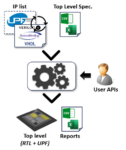Modern SoCs can be complex with hundreds to thousands of IP blocks, so there’s an increasing need to have a front-end build and assembly methodology in place, eliminating manual steps and error-prone approaches. I’ve been writing about an EDA company that focuses on this area for design automation, Defacto Technologies, and … Read More
Tag: upf
2025 Outlook with Dr. Chouki Aktouf of Defacto
Chouki Aktouf is Founder & CEO of Defacto Technologies and Co-Founder of Innova Advanced Technologies. Prior to founding Defacto in 2003, Dr. Aktouf was an associate professor of Computer Science at the University of Grenoble – France and leader of a dependability research group. He holds a PhD in Electric Engineering from… Read More
Defacto Technologies and ARM, Joint SoC Flow at #61DAC
At #61DAC I stopped by the Defacto Technologies exhibit and talked with Chouki Aktouf, President and CEO, to find out what’s new in 2024. ARM and Defacto have a joint SoC design flow by using the Arm IP Explorer tool along with Defacto’s SoC compiler, which helps to quickly create your top-level RTL, IP-XACT and UPF files. This tool… Read More
AMIQ EDA Integrated Development Environment #61DAC
I stopped by the AMIQ EDA booth at DAC to get an update from Tom Anderson about their Integrated Development Environment (IDE), aimed at helping design and verification engineers save time. In my early IC design days we used either vi or emacs and were happy with having a somewhat smart text editor. With an IDE you get a whole new way … Read More
Verific at the 2024 Design Automation Conference
Verific Design Automation will host two well-funded AI EDA startups and latest users of Verific’s front-end platform in its Design Automation Conference (DAC) booth, affirming its position as the leading provider of front-end platforms powering an emerging market.
Primis.ai and Silimate, both founded by former chip designers,… Read More
WEBINAR: Joint Pre synthesis RTL & Power Intent Assembly flow for Large System on Chips and Subsystems
Nowadays, low power design requirements are key for large SoCs (system on chips) for different applications: AI, Mobile, HPC, etc. Power intent management early in the design flow is becoming crucial to help facing PPA (Power Performance Area) design challenges.
With the increasing complexity of such … Read More
Bespoke Silicon Requires Bespoke EDA
When I first heard the term ‘bespoke silicon,’ I had to get my dictionary out. Well versed in the silicon domain, I did not know what bespoke meant. It turns out to be a rather old-fashioned term for tailor made and seems to be very much British English. The word dates from 1583 and is the past participle of bespeak, according… Read More
Using IP-XACT, RTL and UPF for Efficient SoC Design
The ESD Alliance collects and reports every quarter the revenue trends for both EDA and Semiconductor IP (SiP), and the biggest component for the past few years has been the SiP, as IP re-use dominates new designs. For Q4 of 2021 the total SiP revenue was $1,314.3 Million, enjoying a 24.8% growth in just one year. Here’s a chart… Read More
Path Based UPF Strategies Explained
The development of the Unified Power Format (UPF) was spurred on by the need for explicit ways to enable specification and verification of power management aspects of SoC designs. The origins of UPF date back to its first release in 2007. Prior to that several vendors had their own methods of specifying power management aspects … Read More
Working with the Unified Power Format
The Accellera organization created the concept of a Unified Power Format (UPF) back in 2006, and by 2007 they shared version 1.0 so that chip designers would have a standard way to communicate the power intentions of IP blocks and full chips. By 2009 the IEEE received the Accellera donation on UPF , reviewed multiple drafts and published… Read More










